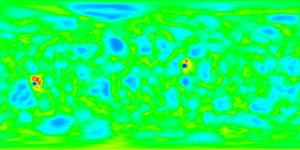Difference between revisions of "Moho"
Nilesrogoff (talk | contribs) (Undo revision 8629 by Nilesrogoff (talk)) |
Nilesrogoff (talk | contribs) |
||
| Line 32: | Line 32: | ||
== Atmosphere == | == Atmosphere == | ||
| − | Moho has | + | Moho has no [[atmosphere]] |
| − | |||
| − | |||
{| class="wikitable" | {| class="wikitable" | ||
| altitude (m) || -1237 || -1015 || -800 || 26 || 97 || 146 || 270 || 488 || 1042 || 1406 || 1994 || 2886 || 3865 || 4816 || 5655 || 8150 | | altitude (m) || -1237 || -1015 || -800 || 26 || 97 || 146 || 270 || 488 || 1042 || 1406 || 1994 || 2886 || 3865 || 4816 || 5655 || 8150 | ||
| Line 53: | Line 51: | ||
| − | |||
| − | |||
== Reference Frames == | == Reference Frames == | ||
Revision as of 19:00, 2 December 2012
Moho is the innermost planet of the Kerbol star system. It is the smallest planet, although it is not the smallest celestial body. It is the only planet known to be tidally locked to Kerbol and the only planet with no natural satellites.
Due to its close proximity to Kerbol, the atmosphere, while thin, is debilitatingly hot. Rockets overheat easily, making a high thrust-to-weight ratio and/or a heat-resistant rocket design necessary for a safe landing.
Contents
Topography
The surface is very mountainous, with surprisingly few craters. The crust almost looks fractured. Up close it is much redder than in the map view and has many white dots. There are two volcanoes (Shown as red circles in the topographic map) on Moho.
Atmosphere
Moho has no atmosphere
| altitude (m) | -1237 | -1015 | -800 | 26 | 97 | 146 | 270 | 488 | 1042 | 1406 | 1994 | 2886 | 3865 | 4816 | 5655 | 8150 |
| specific impulse | 794.5 | 795.1 | 795.6 | 797.1 | 797.2 | 797.3 | 797.5 | 797.7 | 798.3 | 798.6 | 798.9 | 799.3 | 799.6 | 799.7 | 799.8 | 800.0 |
During dawn and dusk, Moho's sky is bluer than its normal red color.
Orbital Statistics
Geosynchronous orbit around Moho is not possible — it would require an altitude of 0.00 m, outside of Moho's sphere of influence.
For a semisynchronous orbit of ½ Moho day (307.75 hours or 1,107,882 seconds) an orbit of 0.00 m above Moho is needed with a velocity of 0.00 m/s.
Reference Frames
Rotational/Inertial transition: ? m
| Warp | Minimum Altitude |
|---|---|
| 5x | 10 km |
| 10x | 10 km |
| 50x | 30 km |
| 100x | 50 km |
| 1,000x | 100 km |
| 10,000x | 200 km |
| 100,000x | 300 km |
Gallery
Changes
- Entirely changed more cratered surface.
- Color changed from red to brown.
- No more superheated atmosphere.
- Initial Release
Notes


